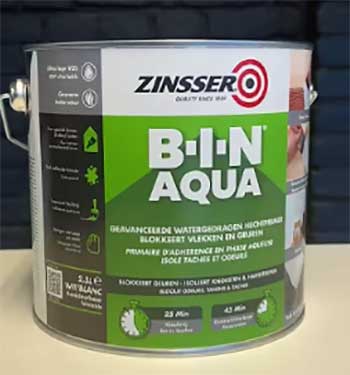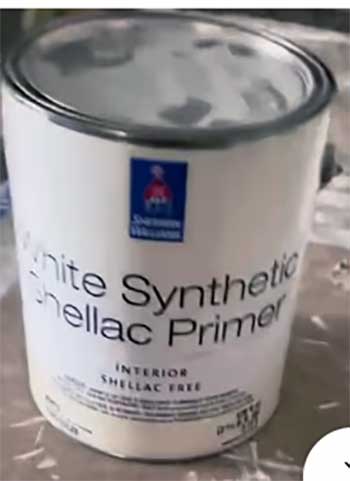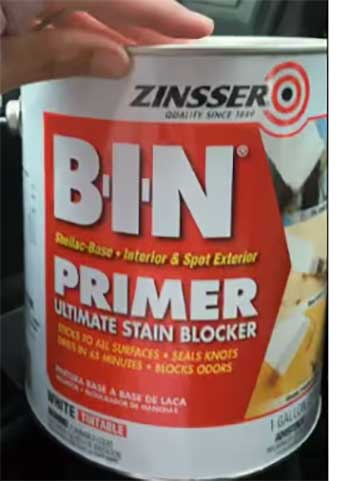If you’ve ever tried to paint over stubborn stains, knots, or glossy surfaces, you know the struggle is real.
That’s where the BIN Advanced Synthetic Shellac Primer comes in.
As someone who’s tackled everything from repurposing old furniture to painting over water-stained walls, I can confidently say this primer is a game-changer.
In this article, I’ll walk you through my experience, the pros and cons, maintenance tips, and how it stacks up against other primers.
By the end, you’ll know whether this product deserves a spot in your DIY toolkit.
My Experience With BIN Advanced Synthetic Shellac Primer

I first heard about BIN Advanced Synthetic Shellac Primer from a Reddit thread where someone raved about its ability to cover laminate surfaces.
Skeptical but desperate (I had a laminate door that refused to hold paint), I decided to give it a shot. Here’s how it went:
- First Impressions: The primer has a strong smell—think alcohol-based—so I made sure to work in a well-ventilated area. The consistency is smooth, and it goes on easily with a brush or roller.
- On Laminate: I applied two thin coats to my laminate door, sanding lightly in between. To my surprise, the paint adhered perfectly, and there was no peeling or scraping, even under heavy use.
- On Stained Wood: I also used it on an old, dark brown bookcase I wanted to paint white. Two coats of primer completely blocked the stain, and the final paint job looked flawless.
- Drying Time: It dries incredibly fast—within 30 minutes—which is a huge plus if you’re working on a tight schedule.
Pros Of BIN Advanced Synthetic Shellac Primer
Let’s break down what makes this primer stand out:
- Ultimate Stain Blocking: It completely covers water stains, smoke damage, and even tannin bleed from wood. No more ghosting!
- High Hiding Power: The bright white base ensures excellent coverage, even over dark colors or stains.
- Fast Drying: You can recoat in just 30 minutes, making it perfect for quick projects.
- Seals Knots and Sap: It locks in resin and sap from wood, preventing them from bleeding through your paint.
- Adheres to Glossy Surfaces: Unlike other primers, it sticks to glossy or slick surfaces like laminate, glass, or metal.
- Versatile: Works on wood, drywall, plaster, metal, and more.
- Smooth Finish: It creates a perfect base for paint, ensuring a professional-looking finish.
- Durable: Once dry, it forms a tough, long-lasting seal that won’t crack or peel.
Cons Of BIN Advanced Synthetic Shellac Primer

Of course, no product is perfect. Here are a few drawbacks I noticed:
- Strong Odor: The alcohol-based formula has a potent smell that can be overwhelming. Make sure to ventilate your workspace.
- Pricey: It’s more expensive than other primers, but in my opinion, the results justify the cost.
- Limited Color Options: It only comes in white, which might not be ideal if you’re priming for a dark paint color.
- Not Water-Based: Cleanup requires mineral spirits or ammonia, which can be messy and inconvenient.
- Fast Drying Can Be a Double-Edged Sword: While it’s great for quick projects, it also means you need to work fast to avoid streaks or lap marks.
- Not Eco-Friendly: The strong chemicals and solvents make it less environmentally friendly compared to water-based primers.
- Can Be Tricky to Sand: If you don’t sand between coats, the finish can feel slightly rough.
- Not Ideal for Large Areas: Due to its strong odor and fast drying time, it’s better suited for smaller projects.
How To Get The Most Out Of BIN Advanced Synthetic Shellac Primer?
To maximize the effectiveness of this primer, follow these tips:
- Ventilate Your Workspace: Open windows and use fans to minimize the strong odor.
- Use the Right Tools: A high-quality brush or roller will help you achieve a smooth, even coat.
- Apply Thin Coats: Thick coats can lead to streaks or uneven drying. Two thin coats are better than one thick one.
- Sand Between Coats: Lightly sanding between coats ensures a smooth finish and better adhesion.
- Work Quickly: The fast drying time means you need to apply the primer efficiently to avoid lap marks.
- Clean Tools Immediately: Use mineral spirits or ammonia to clean brushes and rollers right after use.
- Test on a Small Area: Always test the primer on a small, inconspicuous area to ensure compatibility with your surface.
- Store Properly: Seal the can tightly and store it in a cool, dry place to extend its shelf life.
BIN Advanced Synthetic Shellac Primer Vs. Other Brands

When it comes to primers, there are plenty of options on the market. Here’s how BIN Advanced Synthetic Shellac Primer compares to other popular brands:
- BIN Advanced Synthetic Shellac Primer Vs. Kilz Original Primer:
- BIN is better at blocking stubborn stains like water damage and smoke, while Kilz is more suited for general-purpose priming.
- Kilz has a milder odor, but BIN dries faster and adheres to glossy surfaces more effectively.
- BIN is more expensive, but its superior stain-blocking power makes it worth the extra cost.
- BIN Advanced Synthetic Shellac Primer Vs. Zinsser Cover Stain Primer:
- Both are excellent stain blockers, but BIN dries faster and has a smoother finish.
- Zinsser is oil-based, while BIN is shellac-based, making BIN easier to clean up with ammonia.
- BIN is better for sealing knots and sap, but Zinsser is more affordable.
- BIN Advanced Synthetic Shellac Primer Vs. Rust-Oleum Primer:
- Rust-Oleum is more versatile for metal surfaces, but BIN outperforms it on wood and drywall.
- Rust-Oleum has a milder odor, but BIN provides better coverage and adhesion.
- BIN is more expensive, but its durability and stain-blocking power make it a better long-term investment.
Maintenance Tips For BIN Advanced Synthetic Shellac Primer
To ensure your BIN Advanced Synthetic Shellac Primer performs at its best and lasts for future projects, follow these maintenance tips:
- Store Properly: Always seal the can tightly after use and store it in a cool, dry place. This prevents the primer from drying out or becoming unusable.
- Clean Tools Immediately: Use mineral spirits or ammonia to clean brushes and rollers right after use. If the primer dries on your tools, it can be nearly impossible to remove.
- Avoid Extreme Temperatures: Don’t store the primer in areas that get too hot or too cold, as this can affect its consistency and performance.
- Shake Well Before Use: Over time, the primer can separate. Give it a good shake before each use to ensure an even consistency.
- Test Before Use: If you’ve had the primer for a while, test it on a small area to make sure it still performs as expected.
- Use a Respirator: When working with this primer, especially in enclosed spaces, wear a respirator to protect yourself from the strong fumes.
- Label the Can: If you transfer the primer to another container, label it clearly to avoid confusion with other products.
- Dispose of Responsibly: Since it’s solvent-based, dispose of any leftover primer or cleaning materials according to local regulations.
Also Reads : My Thoughts On Vans Shoe Care Kit
Frequently Asked Questions (FAQ)
It’s used to block stubborn stains, seal knots and sap, and create a smooth base for paint on surfaces like wood, drywall, metal, and laminate.
It dries to the touch in just 15-30 minutes and can be recoated in 30 minutes.
Yes, it’s one of the best primers for blocking stains, sealing surfaces, and adhering to glossy or slick materials.
The strong odor, higher cost, and need for solvent-based cleanup are the main drawbacks.
Stay tuned for the second half of this article, where I’ll dive deeper into maintenance tips, more comparisons, and additional FAQs. Let me know when you’re ready for me to continue!
Also Reads : My Thoughts On Marfa Cabinets
Conclusion
After using the BIN Advanced Synthetic Shellac Primer on multiple projects, I can confidently say it’s one of the best primers on the market for tackling tough stains, sealing knots, and adhering to glossy surfaces.
While it has a few drawbacks—like the strong odor and higher price—the results speak for themselves. If you’re dealing with stubborn stains, water damage, or slick surfaces, this primer is worth every penny.
Give it a try, and you’ll see why it’s a favorite among DIYers and professionals alike.
